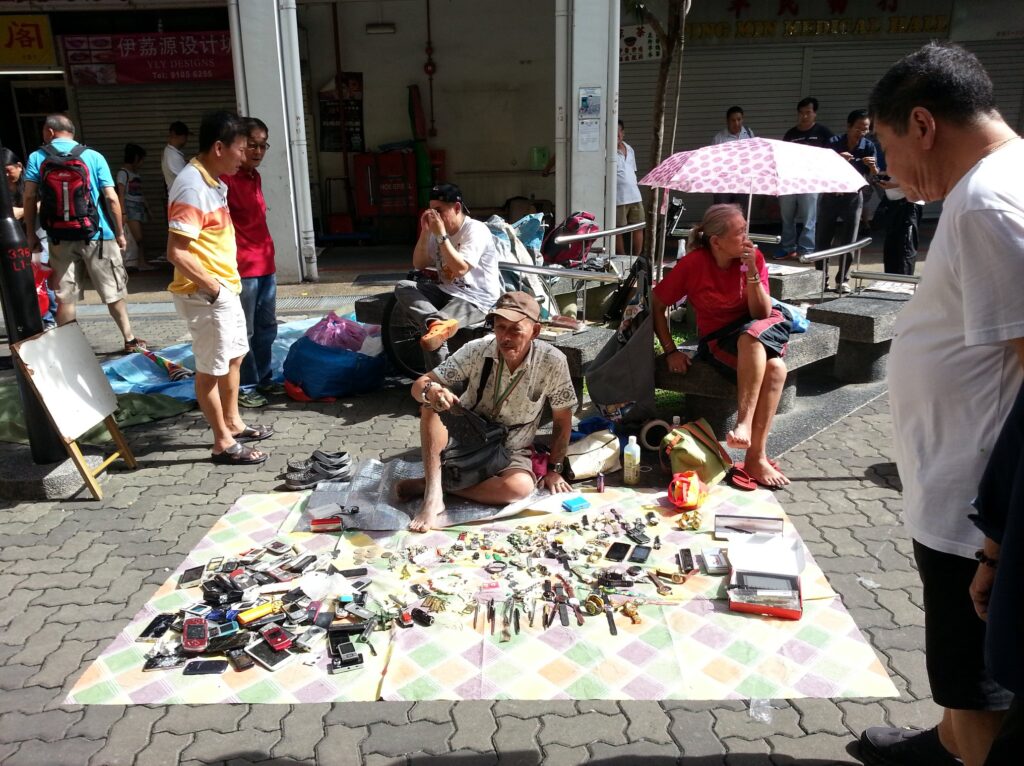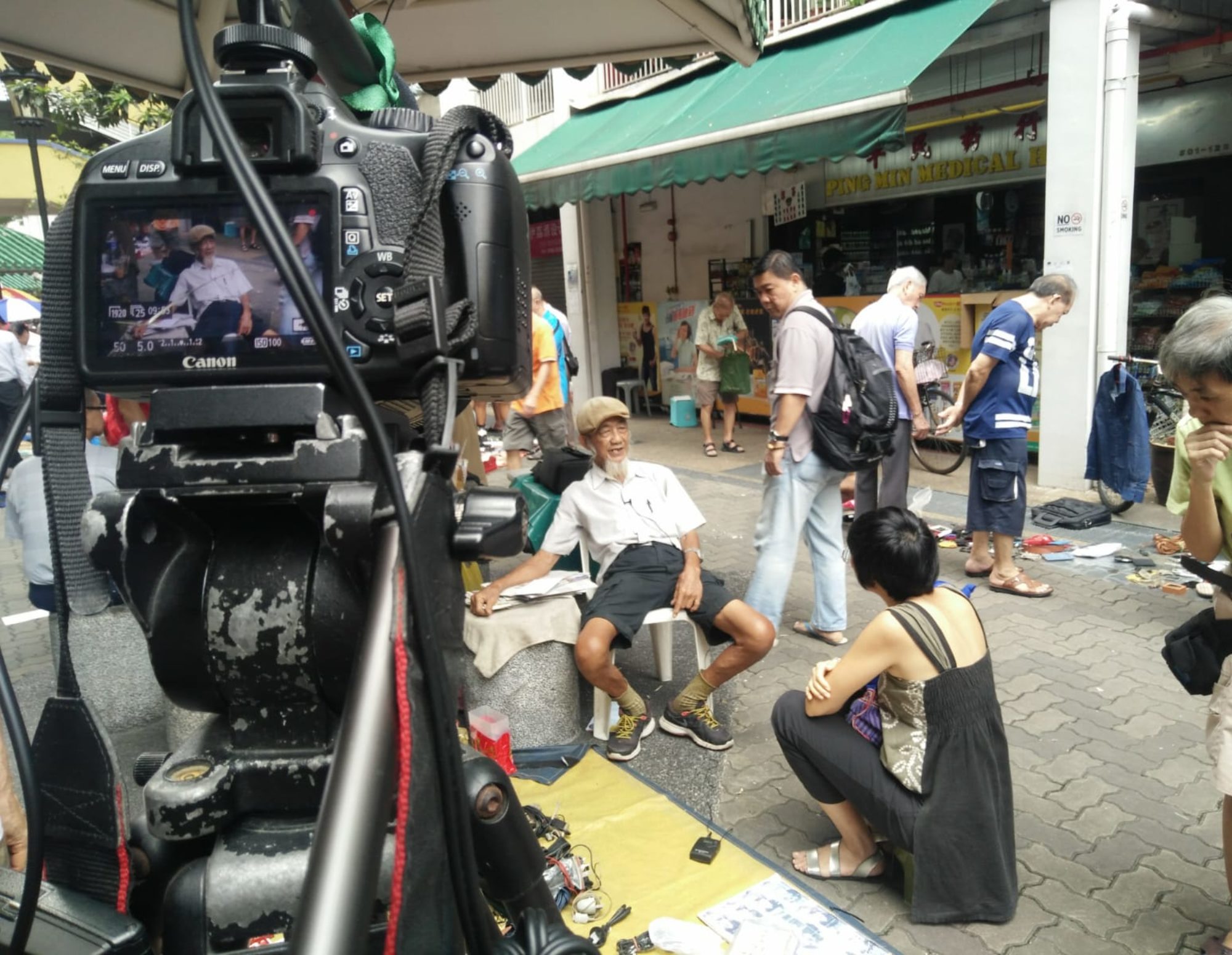Questioning the heroism of ‘self-reliance’

They were in a dire state but I couldn’t tell when Aunty Seah beckoned me over with a friendly wave, and Uncle Chan’s long, morose face broke into a big smile as he loudly called out, ‘Hey, I haven’t seen you for a long time.’
That was our first meeting at the Sago Lane weekend market at Chinatown in April 2018.
In the next few minutes, out tumbled their struggles to find money and the constant fear of playing cat and mouse game with state enforcement officers who would fine them $300 each time they were caught hawking without a license. Pulling a letter out from his waist pouch (stacked neatly and full of letters), Uncle Chan lamented his failed application for public welfare. To crown it all, and brought up in the most causal manner, they were going to be evicted from their one room rental flat in 4 days.
It was some months into shooting the documentary and we were on pretty warm terms. That was when Uncle Chan told me they had put their money on my co-producer, Sharmeen/Sifar and I in their dire state then. They had seen us running around Chinatown with our camera interviewing hawkers for the past months. He knew we would help him, and he was unabashed to ask. That was him, the hustler.
Madam Seah was no wall flower herself. More than once, I overheard her causal conversations with acquaintances in the kopitiam took a gentle turn into soft selling as she pulled out little trinkets from her bag. The hustling couple who were full of life and the spirit of never-say-die.
What else could they rely on? In their 60s, childless and living off a small income from street hawking, they had been left behind in the digital and education divide. It took a while before I realised that they had never taken the MRT before. Navigating the MRT stations and transfers was too bewildering, even though Uncle Chan was quite savvy with his mobile phone by then.
Sometimes never-say-die is errorously mistaken as self-reliance. The latter is the ideology enshrined in our national narrative of how tiny Singapore with little natural resource became an economic miracle. No one owes you a living. We were repeatedly told by our Ministers.
Self-reliance is valourised in our mainstream media. The Channel News Asia Elderly Poor series interviewed an ice cream seller, Mr Ng, 85, and a hawker’s assistant, Mr Ong, 69, who repeated the mantra that they did not want to ask for a handout. They would rather work than live on social welfare. In fact, Mr Ng, in a light moment, said he was confident he would live to the ripe old age of 106, and until then, he would be out on the street selling ice cream, rain or shine.
The interviewer repeated his words (106 year old?) as if asking for some kind of clarifications or affirmation.
‘Yes,’ came the answer.
I wonder if the interviewer was being ironic. Regardless, it feeds into our treasured mantra that there is no free lunch in the world. The first line of social safety network is our family in a neoliberal state. This has always been the unwavering bastion of our welfare system, or rather our anti-welfare stance.
The Ministry of Social & Family that disburses welfare describes its approach towards ‘the needy’ as one that relies on three principles: “help the needy and their families achieve self-reliance; encourage families to be the first line of support for the needy; spur community organisations to participate in helping the needy under a ‘Many Helping Hands’ approach” (MSF, 2014c).
Self-reliance was also cited as a reason by Mr Ng and Mr Ong for not turning to social welfare. The interviewer didn’t probe further. Self-reliance was taken at face value.
Rooted in nineteenth-century American philosophy, the idea of self reliance was popularised by neoliberal policymakers in West, and widely adopted by other countries including Singapore across the twentieth century as a political and socio-economic ideal for a modern, liberal society in which the individual has the capacity for self-care1. The individual is the emphasis. ‘one relies on oneself rather than seeking support in external commitments’.8
But the assumption that the rugged individual holding up his or her own sky is, of course, very misguided. If we just imagine a day in our life and all the individuals that we rely on to get by – the hawkers who cook for us, the bus captain who sends us around; the colleagues we work with – it is clear no one is an island. Even Robinson Crusoe has his Friday.
And if self reliance as a concept is so thin, what explains its ubiquity or its promotion by our policymakers? The rise of neoliberalism as a political system will shed some light. In a nutshell, at the end of the 1970s, a call for a new way to manage the economy and society from socialist We have to take a peek at Its simplicity has the infectious movement, not unlike Covid.
Self care should never be confused with ‘self-reliance’.
Uncle Chan said as much in one scene when he was still hawking in Sago Lane. “I want to depend on myself. If I make $3 or $5 a day, that will pay for my meals.”
And he continued, “It is very tough to depend on someone to help.” This says a lot. Self-reliance is not necessarily an exercise of free will.
Ironically, it was the forced closure of the Sungei Road market that disrupted their ‘self-reliance’. Do we push the rhetoric of self reliance further and expect these hawkers to somehow find their feet again? Let’s check our facts here. A survey by NTU students in 2017 revealed that most hawkers are low income, poorly educated and at least 55 years of age.
It also begs the question of what will happen to these elderly poor when their bodies fail and they are no longer able to work anymore. Uncle Chan and Aunty Seah didn’t choose to be reliant on handouts. Throughout their lives, they had taken different manuals jobs. Aunty’s list included hawker’s assistant, factory worker, fast food waitress and food seller. Uncle worn quite a few hats himself. He was security manager, private detective, Hokkien opera troupe music performer, used branded watch seller, and, his last job, as a cleaner.
Like them, many Sungei Road market hawkers, I spoke to, were working as manual labourers. Poor family backgrounds and low education levels constrained the job opportunities they could aspire to. The long years of work did not accumulate into sufficient savings for retirement, not since the cost of living in Singapore has inflated with our status as a global city.
Today, we observe old people working in the food courts and hawker centres cleaning tables. Some have become illegal tissue pack sellers. As our government urges us to extend our working lives past retirement in the name of remaining activeTheir long working hours are poorly paid. The little savings they have will not take them far. And they are not the only few facing such dire prospects as Singapore ages in an increasingly precarious and globalised economy.
For the most vulnerable with little family support, and unable or unwilling to access the state’s welfare system, old age is a burden. I remember my attempt to interview an 80 year old Sungei Road market hawker who was blind in one eye, one week before its forced closure. He asked if I could help him find a job in construction. When I offered to help him apply for welfare, I unwittingly ignited a furious tirade. From the jumbled He had unsuccessfully applied for welfare in the past but was rejected 8 times.
In the CNA series, at one point, Mr Ng lived in complete darkness at night because his circuit breaker was shut off. The problem was only fixed after the CNA team inquired on his behalf. In the next few scenes, Mr Ng revealed that he had unpaid rental and utilities arrears because he had no clue how to pay for them. And he declined help because he was too embarrassed to take it.
When the aged poor is silently struggling with his inadequacy, did we mistake that for ‘self-reliance’?
Yet, in response, they are reminded by the state to save for rainy days, and, to those on welfare, to practise proper budgeting.
I remember how in another occasion, Uncle Chan explained their predicament. “I can’t invite my friends to join me for kopi these days. It’s not that I am unwilling to buy a round of kopi but one cup is 90 cents, 4 or 5 cups come up to the cost of a meal.”
Self-reliance should not be the conversation stopper. We don’t want to impose our ideas on how they should live, but we should listen between the lines when the aged poor are trying to hold on to their dignity when they say, ‘self-reliance’.
Uncle Chan and Aunty Seah were neither shy, nor did they hesitate to ask for help or pursue the variety of schemes within their knowledge. Uncle Chan took the lead between the two of them. He felt the responsibility to provide for Madam Seah. He hedged his bet when he first called out to me in the market, and he continued to rope me in to speak on his behalf, take them to the family service centers and discuss the news. He attended five courses sponsored by the government for seniors to learn how to use a mobile phone and a computer to keep a close follow on new developments. He eagerly informed me of the $100 increment for welfare recipients in July 2019 before I could catch up with the news.
This is likely what ‘self-reliance’ looks like. Aged poor like Uncle Chan are trying to solve their own problems. Relying on the government or charity is not their first choice.
At the same time,Uncle Chan and Aunty Seah were not adverse to proactively reaching out to anyone willing to give them a hand. They weren’t waiting quietly for their predicament to be ‘found’.
As such, as a socially situated practice, self-reliance is really mutual reliance. We have always and are very likely going to be interdependent in a society. On the ground, the ‘self’ contained in the ‘self-reliance’ formula is often collective rather than individual.
That there is no such thing as a society but only ‘men and women’ as Margaret Thatcher so famously put it, is an attempt at creating the myth of ‘self-reliance’. A propaganda.
Today, the open air markets of Sungei Road and Sago Lane are only a memory, to be forgotten with time. Larut Road and Pitt Road that once intersected with Sungei Road to demarcate the Sungei Road market were torn off. The ground of the entire site was reworked and grass was planted over. It is a quiet field with the hoardings still standing.
Renovation works were carried out at Sago Lane. It lasted 3 years. The pavilions were rearranged, and landscaping reduced the space for activities.
For Uncle Chan and Aunty Seah, the injustice cuts. They want to tell their story of their struggle for financial security in old age and the broken promise of self-reliance.
#citizenhustler #self #reliance #CNA #elderly #poor #sungeiroad #welfare #singapore
